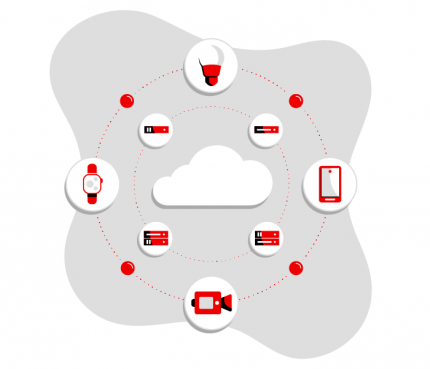The digital transformation of mobile networks is accelerating and cloudification is increasing. Following the core network, radio access network (RAN) solutions are now taking advantage of the benefits of cloud computing. Cloud-based solutions bring more flexibility and efficiency to mobile networks and allow digital service providers (DSPs) to adapt to customer demands with greater agility.
As a continuation of RAN innovation, Red Hat and Nokia have successfully demonstrated an end-to-end 5G data call, using Nokia’s 5G Cloud RAN virtualized distributed unit (vDU) as a containerized application running on Red Hat OpenShift.
RANs connect mobile and internet-of-things (IoT) devices to global networks. Traditionally, they have been proprietary, closed designs, and vertically integrated implementations by a single vendor.
Cloud RAN cloudifies the baseband and decouples hardware and software, allowing each to have independent lifecycle management. In a full cloud RAN solution, both the real-time and non-real-time baseband are virtualized, and split into two separated functions:
-
The virtualized distributed unit (vDU)
-
The virtualized centralized unit (vCU)
This is the architectural foundation for the Nokia and Red Hat 5G demonstration. The over-the-air data call was achieved in Nokia Labs in Finland using Nokia’s next generation vRAN2.0 with containerized vDU running on Red Hat OpenShift.
Hardware and software components in the proof-of-concept included:
-
Nokia 5G Cloud RAN vDU.
-
Nokia radio unit.
-
Nokia Fronthaul Gateway.
-
Nokia AirFrame Open Edge server.
-
Nokia AirFrame Rackmount server.
-
Nokia 5G NSA architecture.
-
Red Hat OpenShift Container Platform.
-
5G mobile phone.
"Nokia AirScale 5G Cloud RAN is an open and cloud-native solution. Together with leading ecosystem players like Red Hat, we help the industry realize the benefits of 5G. As the latest proof of the way forward we have successfully performed an end-to-end 5G data call with our virtualized distributed unit running on Red Hat OpenShift Container Platform,“ said Tomi Vahtera, Head of 5G Cloud Solutions, Nokia
Nokia AirScale 5G Cloud RAN solution
 Nokia 5G Cloud RAN is a solution which fits to existing operator assets and can share edge computing infrastructure with other applications for flexibility and lower total cost of ownership (TCO). Operators can reuse existing CPRI-based radios by converting them to eCPRI with Nokia Fronthaul Gateway.
Nokia 5G Cloud RAN is a solution which fits to existing operator assets and can share edge computing infrastructure with other applications for flexibility and lower total cost of ownership (TCO). Operators can reuse existing CPRI-based radios by converting them to eCPRI with Nokia Fronthaul Gateway.
Nokia Multi-access Edge Computing (MEC) combines application awareness with the radio network awareness of radio intelligent controllers (RICs) to complete the adaptability and agility of Nokia Edge Cloud. Nokia AirFrame Open Edge Server offers an optimized platform for this as the first x86-based product built and tailored for edge deployments of cloud RAN and any other services on the edge.
Red Hat cloud-native platform meets RAN challenges:
Previously Red Hat and Nokia had collaborated to run Nokia’s vRAN1.0 vCU configuration on Red Hat OpenStack Platform. Nokia has now evolved the solution to vRAN2.0 with a containerized vDU that runs on general purpose (x86) platforms. To successfully complete the 5G data call in this proof of concept, Nokia and Red Hat demonstrated vRAN 2.0 running on top of Red Hat OpenShift as the cloud-native infrastructure platform.
As part of this proof of concept, Red Hat optimized the OpenShift configuration to run on a small footprint worker node. To run the RAN application successfully, Red Hat OpenShift Container Platform, along with Red Hat Enterprise Linux, provided the following key characteristics:
-
Low latency, deterministic behavior.
-
Precision Time Protocol to synchronize timing with sub-millisecond accuracy.
-
Hardware acceleration support for vDU functions like beamforming, channel estimation and detection and forward error correction.
-
High performance data plane to optimize throughput.
-
Small-scale footprint to fit space and power requirements.
The Red Hat platform makes it easier to deploy redundant instances, scale efficiently, and improve isolation for services like network slicing. Flexible and scalable RAN services delivered on automated platforms enable faster time to market and more simplified workflows, ensuring repeatability and maintainability. Software-centric RAN solutions increase programmability, and, when combined with intent-based orchestration, they can deliver nearly complete workflow automation.
With Red Hat OpenShift, DSPs can extend their clouds uniformly across cell-sites, edge-sites and regional datacenters. This consistent platform across locations and functions can simplify network management and reduce operations costs.
Nokia and Red Hat have long collaborated in delivering solutions to help DSPs accelerate the transformation of their networks. The latest step forward in the companies’ innovation collaboration is the demonstration of the Nokia vDU solution for 5G RAN on Red Hat OpenShift.
Together, Nokia and Red Hat give you a flexible, adaptable technology foundation to meet today’s needs while helping you prepare for the future. Learn more here about how Red Hat OpenShift can deliver cloud-native infrastructure for your network transformation.
About the author
Cristian Mandras has been working for the last 20 years in the Telco industry, mainly on cloud architecture for radio and core network functions. In his previous role as Chief Architect at Nokia, he managed the architecture specification to build the cloud infrastructure with relevant telco grade features to support Nokia’s real-time radio and core network functions.
In his current role at Red Hat, Mandras works with network equipment providers (NEPs) to design, onboard, validate and certify their containerized or virtualized network functions using the Red Hat portfolio of cloud solutions. He also works with the global telco ecosystem to position Red Hat as a strategic vendor for NEPs.
Browse by channel
Automation
The latest on IT automation that spans tech, teams, and environments
Artificial intelligence
Explore the platforms and partners building a faster path for AI
Open hybrid cloud
Explore how we build a more flexible future with hybrid cloud
Security
Explore how we reduce risks across environments and technologies
Edge computing
Updates on the solutions that simplify infrastructure at the edge
Infrastructure
Stay up to date on the world’s leading enterprise Linux platform
Applications
The latest on our solutions to the toughest application challenges
Original shows
Entertaining stories from the makers and leaders in enterprise tech
Products
- Red Hat Enterprise Linux
- Red Hat OpenShift
- Red Hat Ansible Automation Platform
- Cloud services
- See all products
Tools
- Training and certification
- My account
- Developer resources
- Customer support
- Red Hat value calculator
- Red Hat Ecosystem Catalog
- Find a partner
Try, buy, & sell
Communicate
About Red Hat
We’re the world’s leading provider of enterprise open source solutions—including Linux, cloud, container, and Kubernetes. We deliver hardened solutions that make it easier for enterprises to work across platforms and environments, from the core datacenter to the network edge.
Select a language
Red Hat legal and privacy links
- About Red Hat
- Jobs
- Events
- Locations
- Contact Red Hat
- Red Hat Blog
- Diversity, equity, and inclusion
- Cool Stuff Store
- Red Hat Summit

